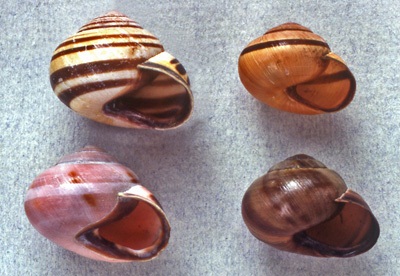Cepaea nemoralis and C. hortensis

Cepaea nemoralis
Cepaea nemoralis nemoralis (L. 1758)
Description: 12 - 22 x 18 -25 mm. Shell globular, slightly depressed, with a conical spire of 5½ convex whorls. The umbilicus is completely sealed (rarely very slightly open) by the thickened lip which is usually dark brown. Shell brightly coloured, glossy, with growth-ridges rather weak and irregular and with 0 - 5 dark spiral bands.
Habitat: Very varied, woods, hedges, scrub, grassland and dunes. Spread by man.

Cepaea hortensis
Cepaea hortensis (O.F. Müller. 1774)
Description: 10 - 17 x 14 -20 mm. The shell is usually glossier and more globose than C. nemoralis, with a low convex spire of about 5½ whorls. The umbilicus is completely sealed by the lip. Mouth usually with a white thickened lip. Shell brightly coloured, glossy, with growth-ridges rather weak and irregular and with 0 - 5 dark spiral bands.
Habitat: Very varied, woods, hedges, grassland and dunes, but commonly in wetter or colder places than C. nemoralis.
Both species are exceptionally variable in both shell colour and banding. The image below shows some examples of Cepaea nemoralis. C. hortensis exhibits similar variations, but the lip colour is usually white.

